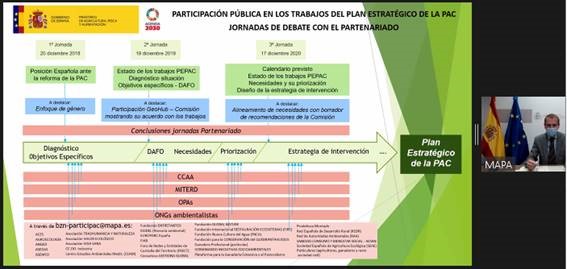
21 de December de 2020
December 21, 2020 On December 17, 2020, the third day of debate on the status of the CAP Strategic Plan 2023-2027 took place to report on the progress of the work carried out so far and to involve all stakeholders in its development. The General Secretariat of Agriculture and Food of the Ministry of Agriculture, Fisheries and Food (MAPA) and the National Rural Network (RRN) organized the event.
The event, opened by Carolina Gutiérrez, Deputy Director of Rural Development, also included the participation of Susana Humanes, Joaquín Rodríguez, and Ignacio Atance, from the Deputy Directorate General of Agricultural Policy Planning.
In this first part, the status of the negotiations and the work schedule were presented, as well as the prioritization of the identified needs for the development of the intervention strategy , as well as its design. The new CAP, which will come into force two years late, will be less oriented toward compliance with regulations and more toward results and performance . Furthermore, 40% of the CAP budget will be allocated to climate and environmental purposes. This first part of the day also highlighted the importance of these meetings, which provide "continuity and are reflected in the Strategic Plan."
The fundamental change of this reform is the development of a single Plan for the entire territory , which will include the designed interventions based on the analysis of the needs of the agricultural sector and rural areas, linked to each of the nine specific objectives and the cross-cutting objective. In this sense, the 85 needs identified in the previous phases of the work, organized into five blocks (economic, environmental, rural, consumer, and AKIS), will allow for improved design of the Strategic Plan's interventions.
Although the Subdirectorate General for Agricultural Policy Planning points out that prioritizing the Plan's needs has not been a simple task, criteria such as commitments (synergies of needs with other policies), connections (relationship of needs with more than one objective), metrics (whether or not indicators exist to measure the impact and outcome of the need), and the relevance of the needs in relation to the objective have allowed prioritization in each of the blocks. This prioritization will be complemented with additional information on the importance of each need in each Autonomous Community, reflected through the Territorial Criterion.
In addition, the MAPA proposals regarding various Plan interventions were explained. Regarding the first pillar of the CAP, the discussion focused on the status of the genuine farmer, basic income support for sustainability, payment caps and redistributive payments, eco-schemes, coupled aid, and other sectoral interventions. Regarding the second pillar, discussion focused on the EAFRD distribution criteria and the performance reserve, the promotion of Agricultural Knowledge and Innovation Systems (AKIS), generational renewal, and gender equality.
The closing of this session was led by the Secretary General, Fernando Miranda, who emphasized the importance of participation and the need to provide any additional input at this crucial moment, such as defining the interventions and measures that will address the identified needs. Although the process is broad and involves participation, it is necessary that all input be reflected on paper to achieve the goal of presenting an agreement with the Autonomous Communities in April 2021.
Opinions expressed in the debate
During the day, those who attended the session via Zoom had the opportunity to share their opinions and the proposals of the organizations they represented, participating live to present their questions and comments or via chat.
An online participatory activity was also held, reviewing the most relevant aspects of the blocks identified for this session. The objective of this activity was to discuss and gather proposals, observations, and suggestions from attendees regarding the suitability of the proposals for the design of the intervention logic, based on the needs presented.
All input received will be compiled and analyzed in the coming weeks, and will be taken into account in decision-making during the design phase.
Evolution of the partnership
The first meeting of the Partnership, which took place in December 2018, aimed to report on the proposed CAP Regulations and gather initial input from business associations, trade unions, civil society, and the government, both at the national and regional levels.
At the second meeting, held in December 2019, progress was presented, seeking to resolve some of the remaining uncertainties, moving toward a more effective CAP and thus addressing the real needs of the region.
The main objective of this third meeting was to inform interested entities, associations, and stakeholders about the work carried out in developing the CAP Strategic Plan, seeking to learn about any proposals, observations, and suggestions they could make, and ensuring their participation in the development of the CAP Strategic Plan.
The participation process is still open, and MAPA invites you to continue participating by providing proposals, comments, and reflections via email at bzn-participac2020@mapa.es .
The presentations used, as well as the recording of the event and the resulting documents, will be published on the National Rural Network website , the MAPA website , and on their social media profiles.









